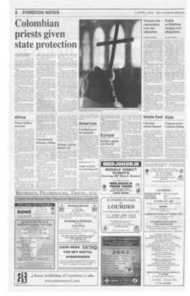Page 9, 5th April 2002
Page 9

Report an error
Noticed an error on this page?If you've noticed an error in this article please click here to report it.
Tags
Share
Related articles
Catacombs Find
Second Oldest Papal Tomb Identified
Catacombs Returned To The Church
Pictures In Church: 2
The Lamp Of Persecution
The catacombs and churches of Early Christian Rome demonstrate that
the faith of the Apostles is alive and well, says Anthony Symondson SJ
The Churches and Catacombs of Early Christian Rome: A Comprehensive Guide by Matilda Webb, Sussex Academic Press £55 hbk/£25 pbk
Nobody who has visited the catacombs can avoid being made aware of the purity of faith of the early Christians. Rome is composed of layers of history; but what makes the Christian layers different from archaeology is that they are still living, and each contributes to a whole that is one with the age of the Apostles and martyrs. Many of the basilicas and Baroque churches are built on sites that go back to the pristine centuries and a great number of Early Christian structures have survived intact, buried deep beneath their foundations.
The most moving of all sites is the Scavi, St Peter's tomb, far down beneath the high altar of St. Peter's basilica, in the buried necropolis on the southern slope of the Vatican hill. To visit it is one of the greatest privileges the Holy See can offer. Descending from the entrance from the Piazza dei Protomartiri Romani, you walk below the foundation walls of Constantine's basilica, down through the narrow streets of Christian and pagan mausolea, eventually reaching the firstcentury burial ground where St Peter's bones lie beneath the marble Tropaion raised by Pope St Anicetus in the second century. There you can glimpse the sealed boxes in a niche which contain the relics of an elderly and powerfully built man. After investigation, they were declared by Pope Paul VI to be those of the Prince of the Apostles. It is difficult to believe otherwise.
Across the other side of the Tiber is the station church of San Sebastiano on the Via Appia Antica, beyond the catacomb of San Callisto. It is set in the Roman countryside near an important pilgrim route connecting San Paulo Fuori le Mura, where St Paul is buried, with San Sebastiano. It was here that in AD 258, in
a columbarium, the relics of SS. Peter and Paul were temporarily kept for safekeeping during the persecutions of Valerian. The catacombs contain a Constantinian funerary hall where banquets, or refrigeria, were held in honour of the dead buried within, and in honour of the Apostles and martyrs buried in the nearby catacomb. From the third to the ninth centuries the composite structure was one of the most important pilgrim sites in Rome and the catacombs include the earliest known fresco of the Nativity.
In the first and second centuries Christians were buried with pagans. Christian cemeteries, known as areae, date from the third century, but by then the number of Christians had greatly increased and as cremation was forbidden a simple and cheap solution was required. Moreover, places were needed where the tombs of martyrs could be marked and where people could hold memorial Masses and funerary banquets on the feast days of saints and martyrs. The solution was large communal Chnstian cemeteries below the ground known as catacombs. One of the first is the labyrinthine Catacomb of Priscilla near the Aurelian walls, divided into three sections composed of galleries lined by /ocu/i, or burial niches. It is in the catacombs that, through the frescoes, we come closest to the Early Church.
On the west slope of the Coelian hill, close to the Lateran Palace, is the fifthcentury church of Santi Giovanni e Paolo, built by Pamtnachius, a Roman senator who was a friend of St Jerome. It was erected on the site of a third-century domus ecclesia or titu/us. The age of State persecutions and anti-Christian statutes was a time of growth for the Church, making specific ecclesiastical buildings essential, but they had to be discreet. This involved the remodelling of existing houses which were acquired by the Church. The best known survival is the titulus Byzantis here which includes a large upper room, Christian frescoes and a bathhouse which was used for baptism. It forms part of a large subterranean building aggregate within which the present church was built.
Not far away is the fourthcentury church of San Clemente, the earliest surviving Christian Church of the basilican form, built on a road that formed another pilgrim route from the Lateran palace to St Peter's. This should not be confused with the marble twelfthcentury basilica built by Pope Paschal II on ground level. The basilica, containing the austere tomb of St Cyril, lies below and is built on an even older structure of the first century. It has the characteristic plan of a nave and two aisles separated by colonnades, a semi-circular apse at the west-end, and a narthex at the entrance. Thus began ecclesiastical architecture, providing a precedent that governed church planning thereafter, and was repeated in successive Roman basilicas.
It was Stendhal who
was in 1828 of the "fatigue caused by the study of the early days of Christianity". It is to archaeologists that we owe the uncovering of so many early Christian sites in Rome and this guide, written by an archaeologist, is a tribute to them. Divided into 13 itineraries with an historical introduction, maps, plans and appendices, but no illustrations, it is confined to the first thousand years of the Church's history and admirably brings together an immense body of learning. I shall take it to Rome when I next go, but it will, I suspect, be of greatest interest to Matilda Webb's professional colleagues.
blog comments powered by Disqus













